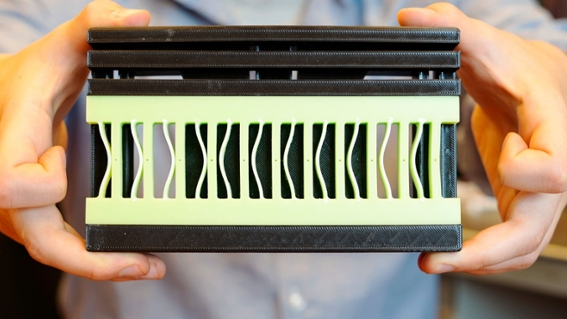Complex behaviors can arise from simple mechanics, and that’s demonstrated by a block of rubber that acts as a counter.
 The block contains beams, and by controlling how the block is compressed, the vertical beams shift in a stable and consistent way, acting as a mechanical counter. It’s a straightforward implementation of the work of two physicists from the Netherlands: [Martin van Hecke] and [Lennard Kwakernaak].
The block contains beams, and by controlling how the block is compressed, the vertical beams shift in a stable and consistent way, acting as a mechanical counter. It’s a straightforward implementation of the work of two physicists from the Netherlands: [Martin van Hecke] and [Lennard Kwakernaak].
This device brings flexures to mind, which are also examples of obtaining complex and useful behavior from seemingly simple objects. We’ve seen flexures used as latches and counters, and we’ve seen 3D printed flexures as a kind of linear actuator.
You can check out the research paper for more details on the rubber beam counter. [Kwakernaak] aims to create a much more complex structure with elements that interact across a plane instead of in a single direction. Such a device would, in effect, be a simple computer.
Watch the beam counter in action in the short video embedded below. See how the elements of the green rubber block move while constrained by an outer frame that helps control the force that is applied. The thin beams flip from left to right, one at a time with each press.















“Such a device would, in effect, be a simple computer.” Finally a computer you can literally punch information into!
What a time to be alive. ^^
We’ll need a rubber ALU for some real number crunching
Prediction: it won’t be long before someone builds a clock with this; because
Eventually any counter in any form will be used in a clock.
It’s about time we had a comment like this.
Arrange the elements in a ring. Now all you need is a reset mechanism. Hm. But you’re right – anything that can be made to count is inevitably made into a clock.
A rubber decade counter… now if multiple units could be chained together…. this could open the door to rubber gates, timers, and maybe even… Flip Flops…
Could we miniaturise this technology? Think of a wearable rubber flip flop.
Instead of an expensive exercise watch you could wear these to count your steps….. maybe made into Crocs. 😁
I had wearable rubber flip-flops in the 1970’s. There’s even a documentary about the “life cycle” of flip-flops in Africa, “Flip-Flotsam”. ;)
Quite impressive! I’m wondering if it would be possible to make a binary counter with these techniques? I guess it would require a counter to reset when it gets pushed up to the next bit.
With a binary counter you mean that the state is represented as a binary number of the beams?
You could, but the coupling between the beams would be a little more complicated.
Currently the thin beams only interact with their neighbor thin beams and only in one direction. If you want a true binary thing you would need coupling between the bits in a very structured and layered way. When in binary, you want to count up from 0111111 to 1000000 the left-most bit would need to know about all the other bits and the pusher while the right-most bit would only need to know about the pusher.
When you ignore the distinction between different magnitudes of “pressing down” you can think of the rubber counter as a cellular automaton. A simple non-turing complete one. Coupling together bi-stable bits in different ways might make something fancier like the famous “Conway’s game of life”.
Mechanical computers already exist as people have managed to figure out how to make transistors and memory with linkages. Out of those transistors you can then end up with the same kind architecture as the computer you are using now.
Making a computer out of a material is different in a way. Conway’s game of life is completely homogeneous for example but you can still program in anything.
Is there a way to read the counter with rubber? I’d imagine not but one could at least add contacts to complete a circuit?
On a controversial note. I wish the video was just slightly improved but that’s not to say I’m not glad there’s a nice little video show casing it.
I do wish the video opened with the demonstration though..one thing TikTok has done so well is nailing how to make good videos. Get the person’s attention in the first half second often the result is making a video which loops around.
On this case just start with the squeezing and end with its made from a block of rubber.
Maybe. Stick some conducting foils on the rubber and you can measure when the beams form contact. There are also scientists that are adding magnetic particles to their rubber to control and measure deformations of beams. Doesn’t really change the mechanics or the computational complexity though but that might be useful for something.
Could be combined with moving fluids to interface with other rubber “circuits” and in-/output devices
Don’t need contacts if it’s not electrical. Rubber can be directly used as a valve, though, when pressed or not pressed against an aperture.
I just rebuilt an EM pinball machine and boy I’d love to see something like this used for a similar purpose. It’s endlessly joyful (imo) to debug EM of components. This could be nicer instead of the big wheel and multiple relays I have to fuss with.
Such a novel device, now to find a use for it.
Like the LASER was for a while, a solution in search of a problem. The “That’s nice, but what does it *do*?” question.